| Article ID | Journal | Published Year | Pages | File Type |
|---|---|---|---|---|
| 4338660 | Neuroscience | 2011 | 13 Pages |
Identification of novel molecules that can induce neuronal differentiation of embryonic stem (ES) cells is essential for deciphering the molecular mechanisms of early development and for exploring cell therapy approaches. Pituitary adenylate cyclase-activating polypeptide (PACAP) and vasoactive intestinal polypeptide (VIP) are known to be implicated early during ontogenesis in cell proliferation and neuronal differentiation. The aim of the present study was to determine the effects of VIP and PACAP on functional differentiation of ES cells. Quantitative-reverse transcription-polymerase chain reaction analysis showed an inversion of the expression pattern of PAC1 and VPAC1 receptors with time. ES cells expressed genes encoding extracellular signal-regulated kinase 1 and 2 and c-jun amino terminal kinase1. ES cells also expressed T-type α1I and α1G, L-type α1C and α1D, and N-type α1B calcium channel subunit mRNAs. Both peptides modified the shape of undifferentiated ES cells into bipolar cells expressing the neuronal marker neuron-specific enolase (NSE). Immunostaining indicated that PACAP intensified T-type α1I subunit immunoreactivity, whereas VIP increased L-types α1C and α1D, as well as N-type α1B subunit. Electrophysiological recording showed that VIP and PACAP enhanced transient calcium current. Moreover, VIP generated sustained calcium current. These findings demonstrate that PACAP and VIP induce morphological and functional differentiation of ES cells into a neuronal phenotype. Both peptides promote functional maturation of calcium channel subunits, suggesting that they can facilitate the genesis of cellular excitability.
▶PACAP and VIP modify the morphology of ES cells into bipolar cells. ▶PACAP and VIP enhance T- and/or L-type inward calcium currents differentiating ES cells. ▶ES cells are able to express PAC1 and VPAC1/2 receptors and MAP-kinases. ▶PACAP and VIP promote the genesis of functional calcium channels during neurogenesis.
